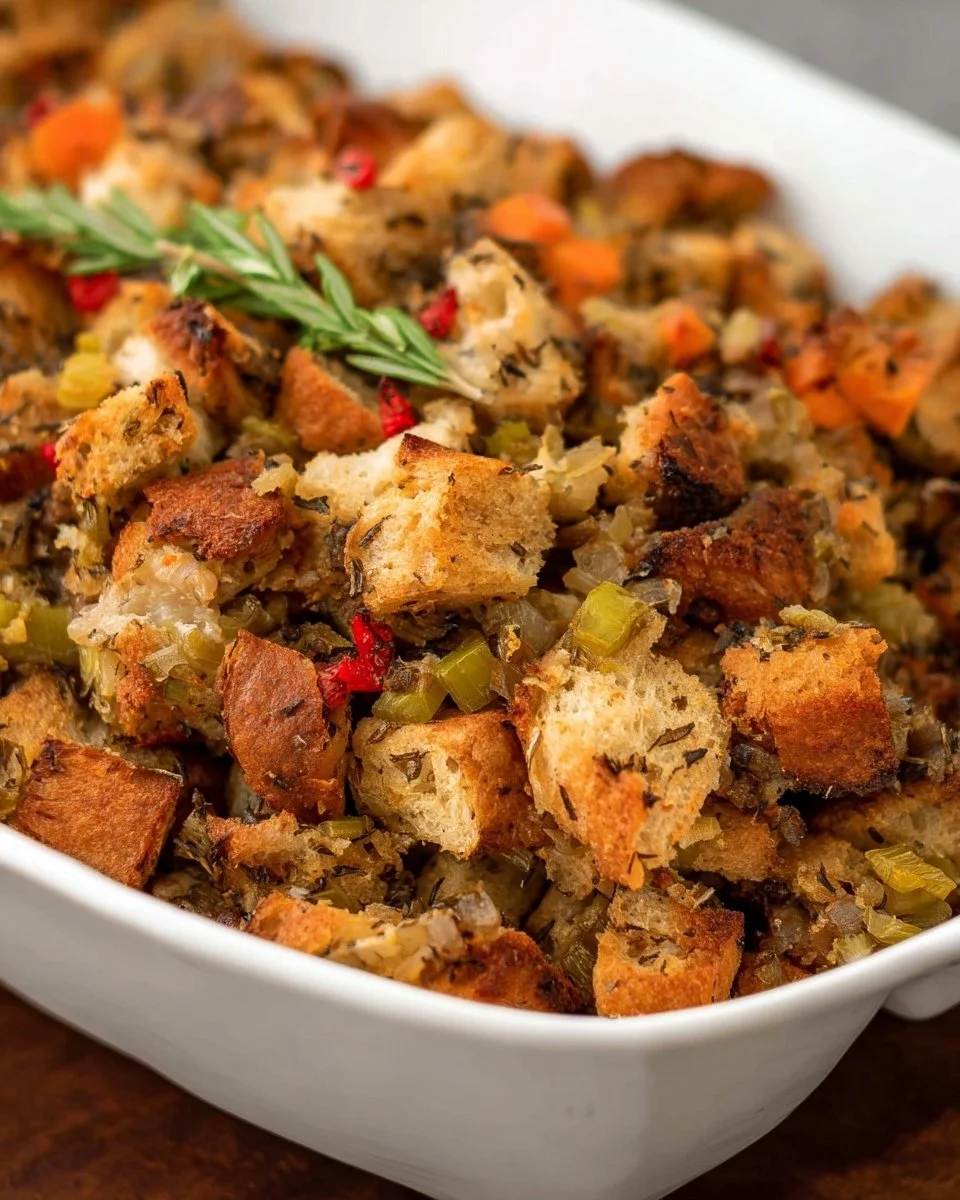Why Make This Recipe
Vegan stuffing is the perfect dish for gatherings and holidays. This recipe is simple, flavorful, and entirely plant-based, making it suitable for everyone. You can enjoy a hearty side dish without any animal products.
This vegan stuffing captures the essence of traditional flavors while offering a fresh twist. It’s great alongside roasted vegetables, in a sandwich, or as a comforting dish on its own. Everyone will appreciate its deliciousness.
Equipment Needed for Vegan Stuffing
To make this vegan stuffing, you need some basic kitchen equipment. Having a good knife and cutting board will help you chop the vegetables easily. You will also need a large skillet for cooking and a 9 by 13 baking dish for baking the stuffing.
A baking sheet is required to toast the bread cubes beforehand. Additionally, measuring cups and spoons will ensure that you get the proportions just right. Lastly, mixing tools like a spatula or wooden spoon will make combining the ingredients a breeze.
What You Need to Make Vegan Stuffing
- 1 loaf bread (14-16 slices or around 12 cups of bread cubes)
- 1 heart of celery (diced, around 5 stalks)
- 1 medium yellow onion (diced)
- 3 carrots (peeled and diced)
- 10 cloves garlic (finely diced or minced)
- 1 1/2 teaspoons salt
- 3 tablespoons ground sage
- 1.5 teaspoons dried thyme
- 1.5 teaspoons dried oregano
- 2 tablespoons vegan butter
- 1/2 teaspoon pepper
- 2 cups veggie stock
- 2 tablespoons vegan butter for topping
How to Cook Vegan Stuffing Step by Step
Start by preheating your oven to 400 degrees Fahrenheit. Next, take your loaf of bread and cut it into cubes. Spread the bread cubes out on a baking sheet in a single layer. Place the baking sheet in the preheated oven and bake the bread for about 10 to 15 minutes, or until the bread is slightly crunchy. Keep an eye on it to prevent burning.
While the bread is toasting, prepare the veggies. In a large skillet, combine the diced celery, onion, carrots, garlic, and 2 tablespoons of vegan butter. Add the 1 1/2 teaspoons of salt, along with the ground sage, dried thyme, dried oregano, and pepper. Place the skillet over medium heat and cook the vegetables, stirring occasionally, for about 10 minutes or until they have softened.
Once the bread cubes are toasted, remove them from the oven. Carefully add the toasted bread cubes to the skillet with the sautéed vegetables. Stir everything together well to combine. Pour in the 2 cups of veggie stock, mixing to ensure all the bread cubes absorb some of the liquid. It’s a good time to taste the mixture and adjust any seasonings if needed.
Now, prepare your baking dish. Grease a 9 by 13 baking dish with some vegan butter. Transfer the stuffing mixture into the greased dish, spreading it out evenly. To finish, dot the top of the stuffing with 2 tablespoons of vegan butter cut into small cubes.
Bake the stuffing in the preheated oven at 400 degrees for 30 to 40 minutes. You can adjust the bake time depending on your texture preference. If you like a drier stuffing, bake longer. For a softer results, take it out earlier.
How to Make Vegan Stuffing
Making vegan stuffing is simple and rewarding. Start with the bread of your choice. You can use whole grain bread, sourdough, or whatever you prefer. Just be sure to cut it into cubes and toast it until golden brown.
The seasoning is where the stuffing gets its flavor. Using fresh herbs like sage, thyme, and oregano brings warmth and depth to the dish. Don’t skimp on the garlic either; it adds aroma and richness.
The mixture of sautéed vegetables enhances the stuffing’s taste and texture. A blend of celery, onions, carrots, and garlic works beautifully together. Combined with the toasted bread and veggie stock, these ingredients create a flavorful dish.
Adjust the salt and pepper to your preference. This easy recipe allows for flexibility, so feel free to experiment with different herbs or even add other veggies, such as mushrooms or spinach, to make it your own.
How to Serve Vegan Stuffing
Vegan stuffing is best served warm and can be a big hit at any meal. It pairs wonderfully with main dishes, especially during holidays or family gatherings. To serve, scoop generous portions onto each plate.
For a lovely presentation, garnish the stuffing with some fresh herbs. This small touch will brighten up the dish and add an appealing scent. Also, consider serving it in the baking dish for a rustic look.
Have some gravy available on the side for those who want an extra sauce. It adds moisture and another layer of flavor. This way, your guests can choose how much they want to drizzle over their stuffing.
What to Serve with Vegan Stuffing
This vegan stuffing goes well with many dishes. It is a perfect side for roasted vegetables, such as Brussels sprouts, carrots, or sweet potatoes. These colors and flavors complement the stuffing beautifully.
Consider serving it alongside a hearty plant-based main dish. Dishes like stuffed bell peppers or lentil loaf make great companions. They share similar flavors, ensuring a satisfying meal.
You may also want to include a fresh salad to go with the stuffing. A simple green salad with a light vinaigrette can refresh the palate. It balances the richness of the stuffing and adds a crunchy texture.
How to Store Vegan Stuffing
Storing leftover vegan stuffing is easy. Allow it to cool completely before transferring it to an airtight container. You can keep it in the refrigerator for about 3 to 4 days.
If you want to store it for a longer period, freeze it. Place the stuffing in a freezer-safe container or a heavy-duty freezer bag. It will stay good for about 2 to 3 months in the freezer.
When you are ready to enjoy your stuffing again, simply thaw it overnight in the fridge. Reheat it in the oven for best results, or microwave it if you’re in a hurry. Just make sure it’s heated through before serving.
Tips to Make Vegan Stuffing
When making vegan stuffing, use day-old bread for the best texture. Stale bread absorbs the veggie stock better, resulting in a heartier stuffing. If your bread is fresh, consider toasting it longer.
Don’t be afraid to experiment with the herbs and spices. A touch of nutmeg or even a hint of cinnamon can bring unique flavors. Adjust the seasonings based on your family’s taste preferences.
Incorporating nuts or dried fruits, like cranberries or walnuts, can add delightful crunch and sweetness. These variations elevate your stuffing and give it a unique flair.
If you want to achieve a crispy top, consider broiling the stuffing for a couple of minutes at the end of baking. This creates a lovely golden crust that many enjoy.
Variation
If you’d like to try something different, consider adding mushrooms for an earthy flavor. Chopped mushrooms can be cooked alongside the other vegetables, adding moisture and depth to the stuffing.
Another excellent variation is to include fruits like apples or cranberries, providing a sweet touch to balance the savory flavors. Not only does this make the stuffing interesting, but it adds a festive spin, especially for fall-themed meals.
You can also make the stuffing gluten-free by swapping out regular bread for gluten-free bread. This way, everyone can enjoy a delicious stuffing regardless of dietary restrictions.
Best Time to Make Vegan Stuffing
Vegan stuffing is fantastic for celebrating special occasions. It’s often made during Thanksgiving, Christmas, or similar gatherings. However, you can enjoy it anytime you want a hearty side dish.
Late fall or winter are the best seasons to make this comfort dish. The warm, cozy flavors match perfectly with the chilly weather. But honestly, any time of year is a great time to enjoy vegan stuffing.
Consider making it for family dinners or potlucks. Its easy preparation and crowd-pleasing qualities make it a hit year-round, so feel free to whip it up anytime you crave comfort food.
Common Mistakes to Avoid
One common mistake is not toasting the bread long enough. Undertoasted bread can lead to a soggy stuffing. Make sure your bread cubes are crispy for the best texture when you bake it.
Another mistake is adding too much vegetable stock. While you want the bread moist, too much liquid can result in an overly wet stuffing. Start with the recommended amount and adjust as needed.
Forget about the seasoning at your peril! Always taste the mixture before baking. Adjusting the salt and herbs can make a huge difference in flavor.
Nutritional Notes
Vegan stuffing is not just delicious; it’s also packed with nutrients. The vegetables in the stuffing provide vitamins while the bread offers carbohydrates for energy. Adding legumes or nuts can increase protein content, making it a balanced side dish.
This recipe is low in saturated fat, as it uses vegan butter instead of dairy. However, be mindful of portions if you’re watching calorie intake, as stuffing can be dense and hearty.
FAQs
Can I make vegan stuffing ahead of time?
Yes! You can prepare your stuffing a day in advance. Simply assemble the ingredients and keep them covered in the fridge until you are ready to bake it.
How do I know when the stuffing is done?
The stuffing should be golden brown on top and firm to the touch. You can also check the inside with a fork; it should not feel soggy.
Can I make this stuffing gluten-free?
Certainly! Just use gluten-free bread and ensure all other ingredients are also gluten-free to accommodate those with dietary restrictions.
Conclusion
This vegan stuffing recipe is simple, hearty, and packed with flavor. It’s a traditional dish that can easily be made plant-based, enjoying the same warmth and comfort. Whether it’s for a special occasion or just a cozy meal at home, it’s sure to please everyone at the table.
By using quality ingredients and some simple techniques, you can create a delicious stuffing that is nutritious and satisfying. Enjoy experimenting with flavors and textures to make it your own!

